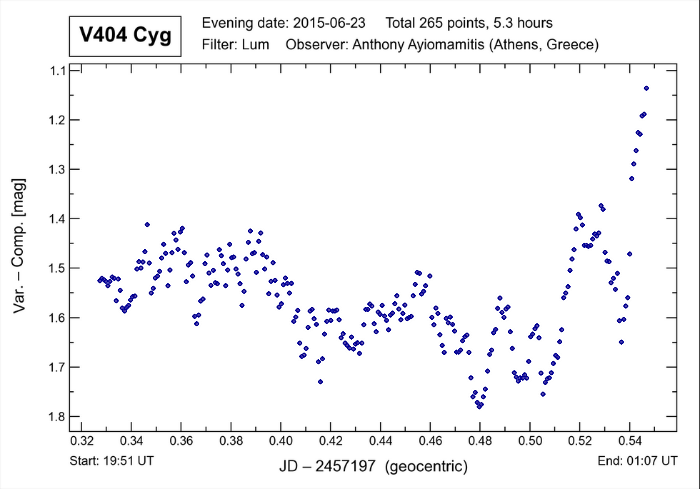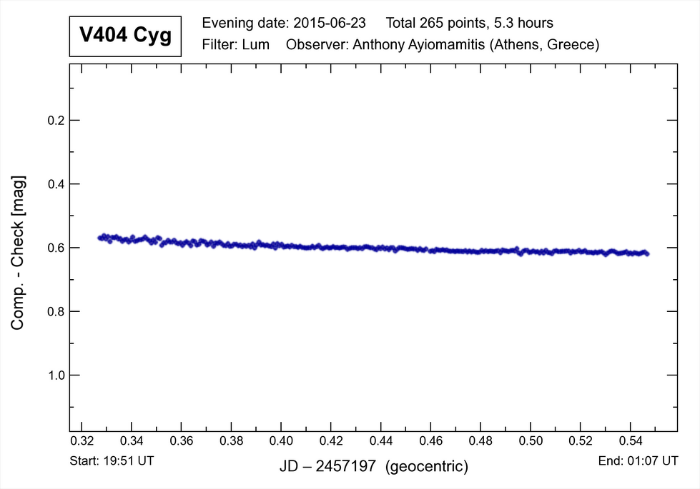
A variable star, as its name suggests, is a star whose magnitude varies intrinsically, in contrast to eclipsing binaries whose magnitude
varies as a result of one star in the binary system eclipsing the other. True variables are one of five types, namely Mira stars, semiregular
stars, cepheids, eruptive variables and, finally, cataclysmic variables. Minimum to maximum magnitude can range from days to many months with
some variables displaying irregular periods.
A popular method for the study of variable stars, particularly short-term variables, is by the use of the technique known as "differential
photometry". Rather than measure the (variable) magnitude of a variable star on an absolute scale, measurements are made over time relative to
one or more non-variable star(s) and these differences are then plotted so as to study and illustrate the relative or differential change in
magnitude. Due to the very large number of variables stars, the field of differential photometry represents one of the key fields in astronomy
whereby the amateur astronomer can make a meaningful and long-lasting contribution to both science and astronomy.
More recently, the search for extrasolar planets (over 750 discovered so far) has identified yet another interesting application for the
practice of differential photometry whereby the minute drops in magnitude of a star hosting an exoplanet are studied. Further details for the
interested party are available here.
Note: Cygnus X-1 has been regarded for a long time as the best and most probable candidate for a black hole.
However, this claim was surpassed with the 1992 discovery and consequent study of the x-ray emissions originating from V404 Cygni. Known
for four previous ourbursts (1938, 1956, 1978 and 1989), V404 Cygni lies a mere 10 light-years away and, similar to Cygnus X-1, also lies in
the constellation of Cygnus. V404 Cygni is a main sequence K-class star with a magnitude of 11.5 (at maximum) and mass of about 0.6 solar
masses which is locked by another "star" with a mass of between 8 and 15 solar masses in a binary formation and with a period of 6.64 days.
Since such a mass precludes any type of white dwarf (or neutron star), the only remaining alternative is a black hole and which at one time
was a member of this binary system and prior to its collapse. Similar to Cygnus X-1, V404 Cygni was discovered in the fall of 1992 thanks to
its x-ray emissions. The variable nature of V404 Cyg was discovered by A. A. Wachmann in 1938.
Further details from the International Variable Star Index are available
here whereas an AAVSO finder chart is available
here.
Note: The fifth documented outburst of V404 Cyg was
announced on June 18, 2015 and the results below indicate the
strong ongoing activity five days later.
|
Variable Star: V404 Cyg Other Designation: GS 2023+338 RA / Dec: 20h 24m 04s / +33° 52' 02" Magnitude: 11.5 - 18.48 (p) Period: 6.64714 days Variability: LMXB/XN Comparison Star: GSC 2693:1051 Check Star: GSC 2693:1473 |
 
|
Date: Jun 23-24, 2015 22:51 - 04:07 UT+3 Location: Athens, Greece Equipment: AP 305/f3.8 Riccardi-Honders AP 1200GTO/CP3 GEM SBIG ST-10XME SBIG CFW10 SBIG LRGB filters Integrations:
Temperatures:
Software: CCDSoft V5.00.201 AIP4Win V2.4.0 Processing: Reduction Differential Photometry |